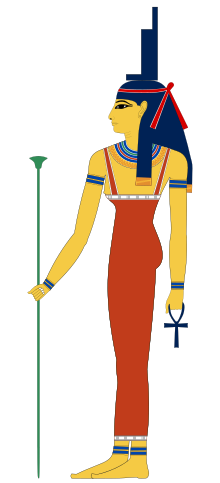
Back Isis Afrikaans Isis ALS إيزيس Arabic ايزيس ARZ আইচিছ Assamese Isis AST İsida Azerbaijani Ісіда Byelorussian Изида Bulgarian আইসিস Bengali/Bangla
| Isis | |||||||||
|---|---|---|---|---|---|---|---|---|---|
 Composite image of Isis's most distinctive Egyptian iconography, based partly on images from the tomb of Nefertari | |||||||||
| Name in hieroglyphs | Egyptian: Ꜣūsat[1][2]
Meroitic: Wos[a] or Wusa[2][3]
| ||||||||
| Major cult center | Behbeit el-Hagar, Philae | ||||||||
| Symbol | Tyet | ||||||||
| Genealogy | |||||||||
| Parents | Geb and Nut | ||||||||
| Siblings | Osiris, Set, Nephthys, Horus the Elder | ||||||||
| Consort | Osiris, Min, Serapis, Horus the Elder | ||||||||
| Offspring | Horus, Min, Four Sons of Horus, Bastet | ||||||||
| Part of a series on |
| Ancient Egyptian religion |
|---|
 |
|
|

Isis[Note 1] was a major goddess in ancient Egyptian religion whose worship spread throughout the Greco-Roman world. Isis was first mentioned in the Old Kingdom (c. 2686 – c. 2181 BCE) as one of the main characters of the Osiris myth, in which she resurrects her slain brother and husband, the divine king Osiris, and produces and protects his heir, Horus. She was believed to help the dead enter the afterlife as she had helped Osiris, and she was considered the divine mother of the pharaoh, who was likened to Horus. Her maternal aid was invoked in healing spells to benefit ordinary people. Originally, she played a limited role in royal rituals and temple rites, although she was more prominent in funerary practices and magical texts. She was usually portrayed in art as a human woman wearing a throne-like hieroglyph on her head. During the New Kingdom (c. 1550 – c. 1070 BCE), as she took on traits that originally belonged to Hathor, the preeminent goddess of earlier times, Isis was portrayed wearing Hathor's headdress: a sun disk between the horns of a cow.
In the first millennium BCE, Osiris and Isis became the most widely worshipped Egyptian deities, and Isis absorbed traits from many other goddesses. Rulers in Egypt and its southern neighbor Nubia built temples dedicated primarily to Isis, and her temple at Philae was a religious center for Egyptians and Nubians alike. Her reputed magical power was greater than that of all other gods, and she was said to govern the natural world and wield power over fate itself.
In the Hellenistic period (323–30 BCE), when Egypt was ruled and settled by Greeks, Isis was worshipped by Greeks and Egyptians, along with a new god, Serapis. Their worship diffused into the wider Mediterranean world. Isis's Greek devotees ascribed to her traits taken from Greek deities, such as the invention of marriage and the protection of ships at sea. As Hellenistic culture was absorbed by Rome in the first century BCE, the cult of Isis became a part of Roman religion. Her devotees were a small proportion of the Roman Empire's population but were found all across its territory. Her following developed distinctive festivals such as the Navigium Isidis, as well as initiation ceremonies resembling those of other Greco-Roman mystery cults. Some of her devotees said she encompassed all feminine divine powers in the world.
The worship of Isis was ended by the rise of Christianity in the fourth through sixth centuries CE. Her worship may have influenced Christian beliefs and practices such as the veneration of Mary, but the evidence for this influence is ambiguous and often controversial. Isis continues to appear in Western culture, particularly in esotericism and modern paganism, often as a personification of nature or the feminine aspect of divinity.
Cite error: There are <ref group=Note> tags on this page, but the references will not show without a {{reflist|group=Note}} template (see the help page).